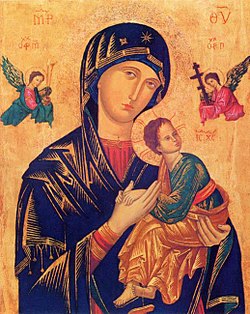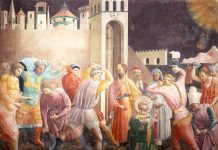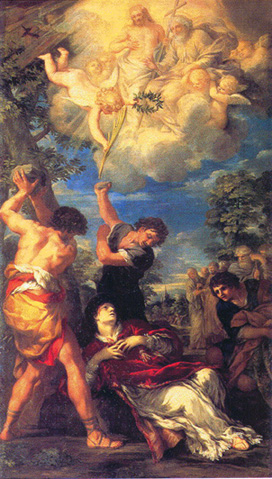Today is the traditional feast of Our Lady of Perpetual Help, signified in one of the most famous ‘icons’ of the Virgin Mother, which, by tradition – legend, some might say – goes back to Saint Luke himself, who besides being a physician was also by the same tradition an artist of sorts, who ‘wrote’ the true living image of Our Lady on the dinner table of the Holy Family.
The icon itself has a long and varied history, and, after a restoration in 1866 by a Polish painter, it now resides in the church of Saint Alphonsus in Rome, under the perpetual care of the Redemptorists. A perpetual novena – if a nine-day prayer may be said to be perpetual – is recited on Wednesdays there, and in churches across the world, beseeching the Mother for whatever help we may need. And we need a lot of it.
Fittingly, this is also the memorial of Saint Cyril, Patriarch of Alexandria and a doctor of the Church, who defended Mary’s traditional title as Theotokos, the ‘Mother of God’, against Nestorius, patriarch of Constantinople, who declared that Mary was only Christotokos, the Mother of Christ, for how, in his mind, could a human creature give birth to the eternal God?
The thing is, Cyril retorted, God is bigger than our minds, and can do far greater things than we may imagine, including truly becoming Man or, more properly, assuming human nature. Cyril defended the hypostatic unity of the Incarnation, that in His one divine Person – hypostasis in Greek – the Second Person of the Blessed Trinity united His divine nature with a human nature, so that all things done in and through that human nature were truly divine, actions of God Himself. Christ was and is not a human person, but a divine one, with two natures. [1]
Nestorius’ doctrine would have bifurcated Christ into two persons, one human and the other divine, the unity between them lost in the vague fog of such terms as ‘moral unity’. In sum, Nestorianism, as it came to be called, would have destroyed the truth of the Incarnation.
Cyril’s teaching – the traditional doctrine of the Church – was vindicated at the Council of Ephesus in 431, which declared for all time Mary’s divine maternity of the Second Person of the Trinity in His human nature, and the icon of the Theotokos was paraded with great joy through the streets. People took theology quite seriously in those days, as they should now. For everything else in life hinges upon what we think of God, and His salvific work.
[1] For those interested in a very valuable, readable and edifying take on this doctrine and its convoluted history, please do peruse Aaron Riches’ book, Ecce Homo.










